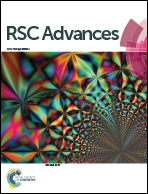Synthesis of surfactant-free SnS nanoplates in an aqueous solution†
Abstract
We report a synthetic route to produce surfactant-free SnS nanoplates with the Pbnm crystal structure. The process is quick and environmentally-friendly, accomplished under mild aqueous conditions. The synthesis involves two steps, formation of an intermediate tin oxide hydroxide (Sn6O4(OH)4) gel and its chemical transformation into SnS nanoplates in the presence of a sulfide precursor (Na2S). We found that addition of a small amount of PVP during the chemical transformation results in the formation of cubic SnS with the Cmcm crystal structure. We discuss the development of the crystal structures on the basis of density functional theory (DFT) calculations on the structure–energy relationship of SnS nanostructures. The optical properties of the SnS nanoplates and nanocubes are compared.


 Please wait while we load your content...
Please wait while we load your content...